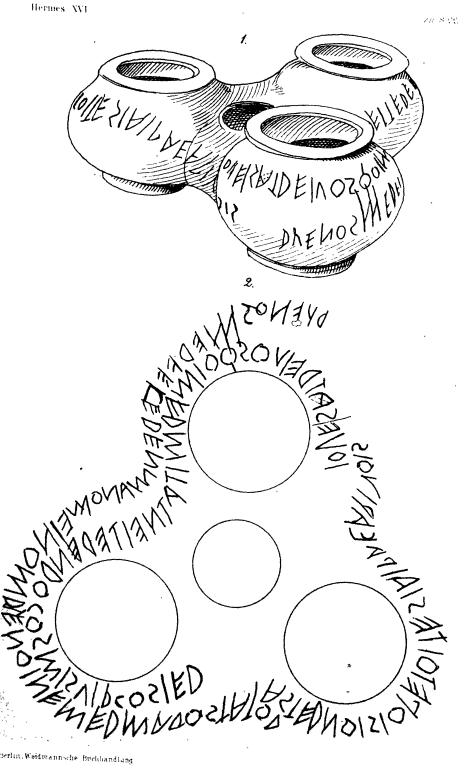Duenos Inscription (Old Latin)

The Duenos inscription, as recorded by Heinrich Dressel (conventionally dated to 6th or early 5th c. BCE)
Courtesy Wikipedia
Introduction
Latin belongs to the Indo-European language family, specifically to the Italic branch of Indo-European. In the early first millennium BCE, Latin was one of many languages spoken on the Italian Peninsula, which hosted several other ancient Italic dialects as well as Ancient Greek (spoken in Greek colonies along the southern coast) and an influential non-Indo-European language known as Etruscan. Using evidence from Latin and its ancient Italic relatives, linguists group Italic into two sub-branches: Latino-Faliscan, comprising Latin and Faliscan, and Osco-Umbrian (also known as Sabellic), including Oscan, Umbrian, South Picene, and several other minor Italic dialects.
Originally Latin was spoken in the Latium region (modern Lazio), mainly along the Tiber river, where Roman civilization first emerged. With the rise of Rome and its military conquest of Italy from the 5th to 3rd centuries BCE, Latin eventually spread throughout the Italian Peninsula and became the dominant language. By comparison with Latin, the other Italic languages are poorly attested and are thought to have become extinct by the Imperial Period.
The following centuries would see Latin spread further due to Roman expansion into southern Europe and the surrounding Mediterranean region. Latin was spoken across the Empire, and in a number of Roman territories, such as Gaul (modern France) and the Iberian Peninsula, Latin all but replaced the local languages, much as it had in Italy. But with the decline of Rome and collapse of Roman civilization by the middle of the first millennium C.E., the unifying effect of the Empire on Latin was weakened and lost. From a late version of spoken Latin known as Proto-Romance, regional dialects began to emerge in the early Middle Ages in southern and western European areas of the former Empire; eventually these developed into the Romance languages of today, including Spanish, Portuguese, French, Italian, and Rumanian.
The Harvard collection is rich in materials for the study of Latin and other ancient Italic dialects. Among its holdings are numerous handbooks, grammars, lexica, and primary materials for the study of Latin and Italic historical linguistics. Of further value are the many dissertations, scholarly journals, and online resources available to the Harvard community.
